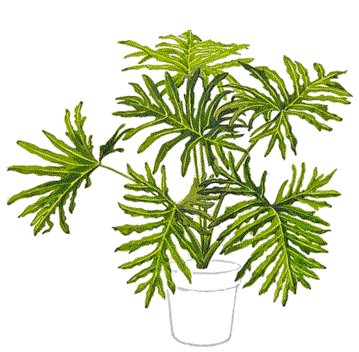Philodendron
CHARACTERISTICS:
From the more than 200 species of philodendrons
that have been discovered in Central and South America and the Caribbean
islands, thousands of hybrids have been developed, providing a great range
of leaf sizes and shapes as well as variations in the form of the plants
themselves. (One plant called philodendron is not
a philodendron at all: split-leaved philodendron is one of the common names
for Monstera deliciosa) Most philos can be grown in low light.
Some grow in a bush form like the selloum. Some varieties are trained to
grow on a pole to create a slender upright shaped plant. These pole plants
must be continuously pruned to keep the vines on the pole. If the pole
is wooden it will eventually rot, causing the plant to lean over. Styrofoam
poles will break if you're not careful.
Most philodendrons grown indoors are vines,
but some types, called self-heading, send out their leaves from a heavy
clump of growth at their base. In addition, many climbing philodendrons
change leaf size drastically, depending on how they are grown. So long
as they are allowed to trail along the ground or cascade from a hanging
container, they bear moderate-sized leaves, but as soon as they are given
a support upon which to climb, the leaves become gigantic, often several
times as large as the ones that developed before a support was provided.
VARIETIES:
The Burgundy philodendron is an attractive
slow-growing variety with 8- to 12-inch leaves that glisten as though polished.
The Florida philodendron has 4- to 8-inch shiny leaves that are divided
into five widely spaced lobes; the leaf stalks are covered with a reddish
fuzz, and the undersides of the leaves are brownish red. The spearhead
philodendron has 8- to 12-inch dark green leaves shaped like spearheads.
The velvet-leaved philodendron has 2- to 3-inch heart-shaped leaves; the
tops are an iridescent bronze green and the undersides are reddish brown.
The Silver Sheen philodendron has 3- to 4-inch heart-shaped silvery green
leaves. The most popular member of the genus, the heart-leaved philodendron,
has 2- to 4-inch heart-shaped green leaves; it can grow in plain water.
The fiddle-leaved philodendron, rather slow growing but durable, has dense
overlapping 5- to 8-inch leaves shaped like violins. P. radiatum, a handsome
vigorous climber, has 4- to 10-inch deeply lobed heart-shaped leaves; young
seedlings, however, have leaves with few lobes--a stage of development
that confused the plant collectors who first found seedlings of the plant
in the jungles of Central America. As a result the plant was called P.
dubium--that is, doubtful philodendron. The species has since been given
the botanical name P. radiatum.
Among the self-heading philodendrons,
three are particularly outstanding. The cutleaf philodendron is a fine
species for large spaces. It eventually forms a short trunk and becomes
3 to 4 feet tall with a 4- to 6-foot spread. Its handsome leaves grow 12
to 18 inches long and 8 to 12 inches wide. Weber's Self-Heading philodendron
has 8- to 12-inch smooth-edged oval leaves that are very shiny and leathery.
The leaf stalks and the central ribs on the undersides of the leaves are
red. Wendland's philodendron has leathery 12- to 18-inch leaves arising
from a central point like those of the bird's-nest fern, Asplenium nidus.
Wendland's philodendron is unusual among
philodendrons in that it occasionally blossoms indoors. Each of its flowers
consists of a single 6- to 8-inch white cupped petallike bract called a
spathe that is furled in the manner of a calla lily; the tiny true flowers
are borne on the spikelike center, or spadix, within each spathe.
PRUNING:
These fast growing plants have vining
tendencies. Most people prefer a full, leafy looking plant, so it is important
to trim back new growth on the vine tips. This keeps the plant full and
helps prevent the plant from looking stringy.
HOW TO GROW:
Philodendrons do best in bright indirect
or curtain-filtered sunlight; if only artificial light is available, provide
at least 400 foot-candles. Night temperatures of 65° to 70° and
day temperatures of 75° to 85° are ideal. Keep the soil barely
moist at all times. Feed established plants every three or four months,
but wait four to six months before feeding newly purchased or potted plants.
Repot overcrowded plants at any season, using a mixture of 1 part loam,
1 part peat moss or leaf mold and 1 part sharp sand; to each gallon pailful
of this mixture add 1 1/2 teaspoons of 20 per cent superphosphate, 1 tablespoon
of ground limestone and 2 teaspoons of 5-10-5 fertilizer. Otherwise, use
a packaged general-purpose potting soil. Propagate at any season from stem
cuttings, from sections of main stems or by the method known as air layering.
Generally pest free.

